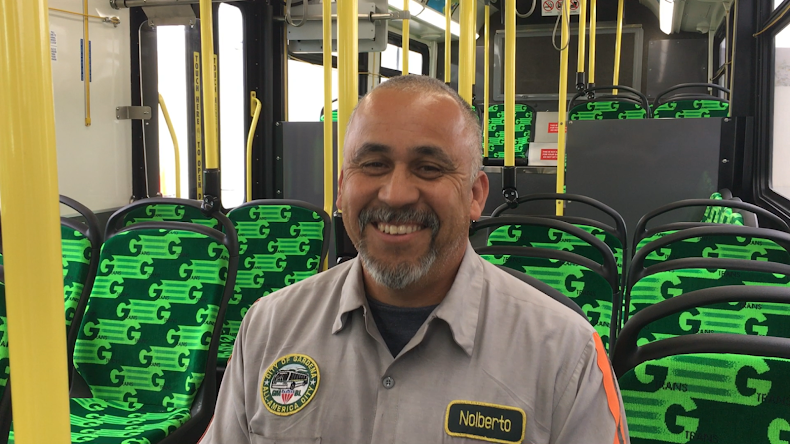Home
Energy Efficiency
Transportation
Transition to Clean Transit Supports Important Workforce Development
Transition to Clean Transit Supports Important Workforce Development

 Much has changed in the 27 years that Nolberto Acosta has worked in bus maintenance, including the technology powering the vehicles.
Much has changed in the 27 years that Nolberto Acosta has worked in bus maintenance, including the technology powering the vehicles. “We’ve switched from diesel to hybrid to electric. It’s a total change,” said Acosta, a GTrans employee of 22 years.
Before that, he worked five years for the Los Angeles County Metropolitan Transportation Authority.
Maintenance needs have dropped since the switch to hybrid gasoline-electric technology, he says. But the work has become more technical, electronic and computer-based.
Now, GTrans is operating five all-electric buses in economically disadvantaged communities throughout the city of Gardena, thanks to a grant from the California Energy Commission.
GTrans converted five buses from its fleet of hybrid gasoline-electric buses using Zero Emission Propulsion System technology. The change was made possible by a $2.7 million grant to GTrans from the California Energy Commission’s Alternative and Renewable Fuel and Vehicle Technology Program (ARFVTP). To date, the program has invested more than $748 million to support advancements in alternative, renewable fuels and the vehicles powered by them.
GTrans and Gardena officials hope the demonstration of the retrofitted buses will lay the groundwork for similar projects across the country, creating new jobs throughout the transit industry.
The current pilot project supports local workforce development for the employees who built the buses at the Complete Coach Works’ facility in Riverside -- and for the workers who drive and maintain the vehicles.
Acosta has taken two courses preparing him to repair the new electric buses. A new consideration because of the technology is the high voltage nature of the buses’ power system.
 |
| GTrans employee Uneice Jones |
Training also helps maintenance workers like Acosta retain their positions as transportation technology continues evolving. It’s also important for those new to the bus repair trade, and for drivers learning how to handle buses powered by alternative technology.
“Driving the electric buses, the ride is a lot quieter,” said Uneice Jones, who has worked with GTrans for 25 years, eight of them as a bus operator.
She said drivers must now pay extra attention to pedestrians to ensure they are aware of the buses’ movements. It helps that the bus plays voice recordings to alert passersby.
Operators must also learn how to use the buses’ regenerative braking systems, which recover kinetic energy to help power the vehicle. Other new considerations include the buses range per electric charge, and how that range is affected by things including the use of air conditioning.
Jones not only drives the buses, but rides them to and from her home in Gardena.
“I’m always attracted to going green,” she said.


